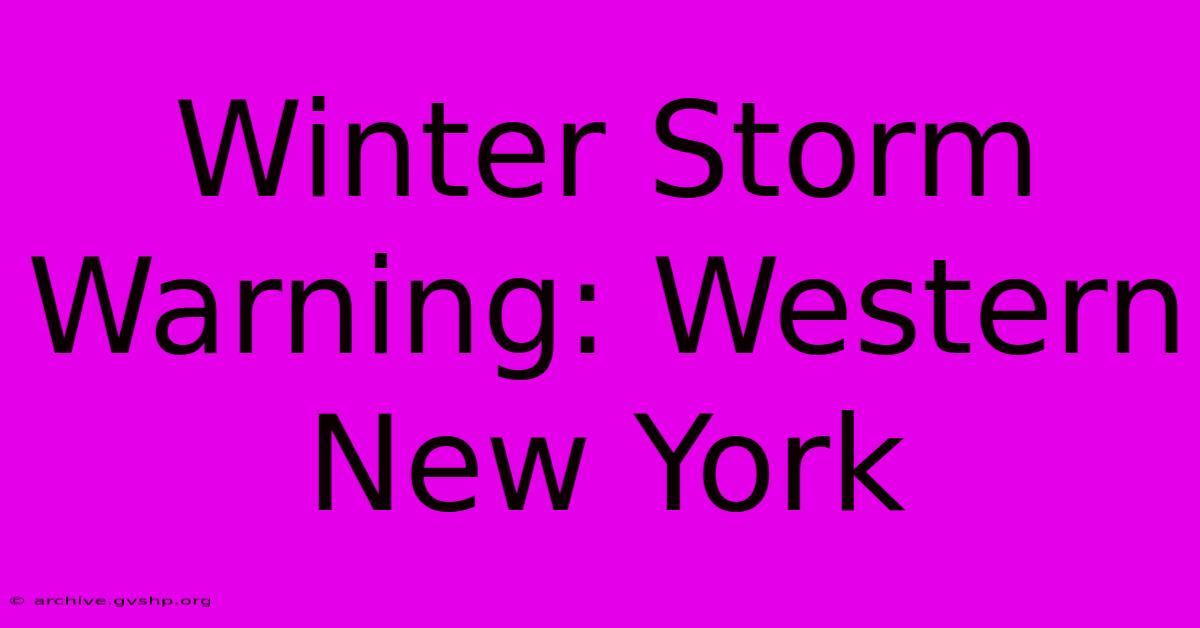Winter Storm Warning: Western New York

Discover more detailed and exciting information on our website. Click the link below to start your adventure: Visit Best Website. Don't miss out!
Table of Contents
Winter Storm Warning: Western New York – Brace for the Blizzard
Western New York is bracing for a significant winter storm, prompting a Winter Storm Warning issued by the National Weather Service. This isn't your average snow flurry; this is a serious weather event with the potential for blizzard conditions, heavy snowfall, dangerously low wind chills, and significant travel disruptions. Understanding the severity of this warning and taking proactive steps to prepare is crucial for ensuring your safety and the safety of your loved ones.
This article will cover everything you need to know about the impending winter storm, including the expected impact, safety precautions, and resources available to help you navigate this challenging weather event.
Understanding the Winter Storm Warning
A Winter Storm Warning isn't issued lightly. It signifies that severe winter weather is imminent or already occurring. In the case of Western New York, this warning indicates the potential for:
- Heavy Snowfall: Accumulations of several feet of snow are possible in certain areas, leading to significant disruptions and dangerous travel conditions.
- Blizzard Conditions: High winds combined with heavy snowfall will create blizzard conditions, reducing visibility to near zero and making travel extremely hazardous.
- Dangerously Low Wind Chills: The combination of cold temperatures and strong winds will result in dangerously low wind chills, posing a serious threat of hypothermia and frostbite.
- Significant Travel Disruptions: Roads will likely become impassable, leading to closures of major highways and potentially stranding travelers. Air travel will also likely be significantly affected.
Preparing for the Winter Storm
Preparation is key to mitigating the risks associated with this severe winter storm. Here's a comprehensive checklist to help you get ready:
Before the Storm Hits:
- Create an Emergency Kit: Gather essential supplies like food, water, medications, flashlights, batteries, a first-aid kit, and blankets. Consider having a battery-powered radio to stay updated on weather reports.
- Charge Devices: Ensure your cell phones, laptops, and other electronic devices are fully charged. Consider having a portable power bank as a backup.
- Stock Up on Essentials: Purchase extra groceries, including non-perishable items, and any necessary medications.
- Prepare Your Home: Insulate pipes to prevent freezing, and bring any outdoor furniture or decorations inside.
- Check on Vulnerable Neighbors: Reach out to elderly neighbors or those with disabilities to ensure they are prepared and have access to necessary resources.
- Alert Family and Friends: Inform your family and friends about the impending storm and your preparedness plan.
During the Storm:
- Stay Indoors: Avoid unnecessary travel during the storm. If you must go out, inform someone of your destination and estimated time of arrival.
- Monitor Weather Reports: Stay updated on the latest weather information from the National Weather Service or reliable news sources.
- Conserve Energy: Reduce energy consumption to prevent power outages.
- Stay Warm: Dress in layers and use blankets to stay warm. Avoid strenuous activities that could lead to dehydration and overheating.
- Be Aware of Carbon Monoxide Poisoning: Never use a generator, grill, or other fuel-burning devices indoors. Carbon monoxide poisoning is a serious and potentially fatal hazard.
After the Storm:
- Check for Damage: Carefully inspect your home and property for any damage caused by the storm.
- Clear Snow and Ice: Clear walkways and driveways carefully, taking precautions to avoid injury.
- Avoid Downed Power Lines: Stay away from downed power lines and report them immediately to your utility company.
- Check on Neighbors: Check on elderly neighbors or those with disabilities to ensure their safety and well-being.
- Be Patient: Restoration of power and services may take time after a significant winter storm.
Specific Considerations for Western New York:
Western New York’s unique geography and climate present specific challenges during winter storms. The Lake Effect snow phenomenon can cause localized intense snowfall, leading to significantly higher accumulations in certain areas. Be particularly aware of travel advisories and restrictions specific to your region. Stay informed about road closures and potential travel delays.
Resources:
- National Weather Service: The primary source for accurate weather information.
- New York State Department of Transportation (NYSDOT): Provides updates on road conditions and closures.
- County Emergency Management Agencies: Your local emergency management agency provides crucial information and assistance during emergencies.
Conclusion:
The Winter Storm Warning for Western New York is a serious matter. Taking proactive steps to prepare, staying informed, and prioritizing safety are paramount. By following the guidelines outlined in this article, you can significantly reduce your risk and ensure your well-being during this challenging weather event. Remember, preparedness is the best defense against the dangers of a severe winter storm. Stay safe, Western New York!

Thank you for visiting our website wich cover about Winter Storm Warning: Western New York. We hope the information provided has been useful to you. Feel free to contact us if you have any questions or need further assistance. See you next time and dont miss to bookmark.
Also read the following articles
| Article Title | Date |
|---|---|
| Nearly All Of Puerto Rico Dark On Nye | Jan 02, 2025 |
| Watch Blackhawks Winter Classic 2025 Date Time | Jan 02, 2025 |
| Nyc Subway Blaze Victim Named Debrina | Jan 02, 2025 |
| Aaron Brown Cnn Anchor Dies At 76 | Jan 02, 2025 |
| College Football Bowl Game Tv Schedule Today | Jan 02, 2025 |
| Jolie Pitt Divorce Final Settlement Reached | Jan 02, 2025 |
| Veteran Newsman Aaron Brown Passes Away | Jan 02, 2025 |
| Winter Classic Sights And Sounds Blues Vs Hawks | Jan 02, 2025 |
| Washington Vs Louisville Where To Watch | Jan 02, 2025 |
| Democrats Policies Driving Economic Change | Jan 02, 2025 |
